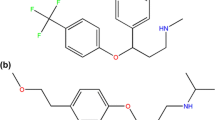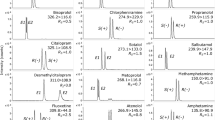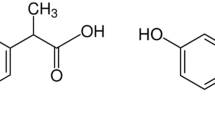Abstract
The accurate quantification of enantiomers is crucial for assessing the biodegradation of chiral pharmaceuticals in the environment. Methods to quantify enantiomers in environmental matrices are scarce. Here, we used an enantioselective method, high-performance liquid chromatography with fluorescence detection (HPLC-FD), to analyze two beta-blockers, metoprolol and atenolol, and the antidepressant fluoxetine in an activated sludge consortium from a wastewater treatment plant. The vancomycin-based chiral stationary phase was used under polar ionic mode to achieve the enantioseparation of target chiral pharmaceuticals in a single chromatographic run. The method was successfully validated over a concentration range of 20–800 ng/mL for each enantiomer of both beta-blockers and of 50–800 ng/mL for fluoxetine enantiomers. The limits of detection were between 5 and 20 ng/mL and the limits of quantification were between 20 and 50 ng/mL, for all enantiomers. The intra- and inter-batch precision was lower than 5.66 and 8.37 %, respectively. Accuracy values were between 103.03 and 117.92 %, and recovery rates were in the range of 88.48–116.62 %. Furthermore, the enantioselective biodegradation of atenolol, metoprolol and fluoxetine was followed during 15 days. The (S)-enantiomeric form of metoprolol was degraded at higher extents, whereas the degradation of atenolol and fluoxetine did not show enantioselectivity under the applied conditions.


Similar content being viewed by others
References
Aboul-Enein HY, Ali I (2002) Optimization strategies for HPLC enantioseparation of racemic drugs using polysaccharides and macrocyclic glycopeptide antibiotic chiral stationary phases. Il Farmaco 57(7):513–529
Berthod A (2009) Chiral recognition mechanisms with macrocyclic glycopeptide selectors. Chirality 21(1):167–175
Berthod A, He BL, Beesley TE (2004) Temperature and enantioseparation by macrocyclic glycopeptide chiral stationary phases. J Chromatogr A 1060(1–2):205–214
Christen V, Hickmannb S, Rechenbergb B, Fent K (2010) Highly active human pharmaceuticals in aquatic systems: a concept for their identification based on their mode of action. Aquat Toxicol 96(3):167–181
Cleuvers M (2005) Initial risk assessment for three β-blockers found in the aquatic environment. Chemosphere 59(2):199–205
De Andrés F, Castañeda G, Ríos Á (2009) Use of toxicity assays for enantiomeric discrimination of pharmaceutical substances. Chirality 21(8):751–759
Flaherty CM, Dodson SI (2005) Effects of pharmaceuticals on Daphnia survival, growth, and reproduction. Chemosphere 61(2):200–207
Fono LJ, Kolodziej EP, Sedlak DL (2006) Attenuation of wastewater-derived contaminants in an effluent-dominated river. Environ Sci Technol 40(23):7257–7262
Foran CM, Weston J, Slattery M, Brooks BW, Huggett DB (2004) Reproductive assessment of Japanese Medaka (Oryzias latipes) following a four-week fluoxetine (SSRI) exposure. Arch Environ Contam Toxicol 46(4):511–517
Henry TB, Black MC (2008) Acute and chronic toxicity of fluoxetine (selective serotonin reuptake inhibitor) in Western Mosquitofish. Arch Environ Contam Toxicol 54(2):325–330
Kasprzyk-Hordern B (2010) Pharmacologically active compounds in the environment and their chirality. Chem Soc Rev 39(11):4466–4503
Kümmerer K (2009) The presence of pharmaceuticals in the environment due to human use - present knowledge and future challenges. J Environ Manag 90(8):2354–2366
Lao W, Gan J (2012) Enantioselective degradation of warfarin in soils. Chirality 24(1):54–59
Ma Y, Xu C, Wen Y, Liu W (2009) Enantioselective separation and degradation of the herbicide dichlorprop methyl in sediment. Chirality 21(4):480–483
MacLeod SL, Wong CS (2010) Loadings, trends, comparisons, and fate of achiral and chiral pharmaceuticals in wastewaters from urban tertiary and rural aerated lagoon treatments. Water Res 44(2):533–544
Patrick R, Jan S, Andreas S, Timm K, Burkhard S (2011) First evidence for a stereoselective incorporation of nonylphenol diastereomers in soil-derived organo-clay complexes. Environ Chem Lett 9(2):293–299
Piersma AH, Luijten M, Popov V, Tomenk V, Altstein M, Kagampang F, Schlesinger H (2009) Endocrine-disrupting chemicals in food. In: Shaw I (ed) Pharmaceuticals. University of Canterbury, New Zealand, pp 459–518
Ribeiro A, Castro P, Tiritan M (2012) Chiral pharmaceuticals in the environment. Environ Chem Lett 10(3):239–253
Sánchez-Argüello P, Fernández C, Tarazona JV (2009) Assessing the effects of fluoxetine on Physa acuta (Gastropoda, Pulmonata) and Chironomus riparius (Insecta, Diptera) using a two-species water-sediment test. Sci Total Environ 407(6):1937–1946
Stanley JK, Ramirez AJ, Chambliss CK, Brooks BW (2007) Enantiospecific sublethal effects of the antidepressant fluoxetine to a model aquatic vertebrate and invertebrate. Chemosphere 69(1):9–16
Tong AYC, Peake BM, Braund R (2011) Disposal practices for unused medications around the world. Environ Int 37(1):292–298
Validation of Analytical Procedures: Text and Methodology Q2(R1) (1996) International Conference on Harmonization, http://private.ich.org/LOB/media/MEDIA417.pdf
Wang X, Wang X, Zhang H, Wu C, Wang X, Xu H, Wang X, Li Z (2012) Enantioselective degradation of tebuconazole in cabbage, cucumber, and soils. Chirality 24(2):104–111
Acknowledgments
The work has been supported by Fundacão para a Ciência e Tecnologia—FCT (PhD grant attributed to Ana Rita Ribeiro, SFRH/BD/64999/2009, from QREN-POPH, European Social Fund and MCTES). Authors also wish to acknowledge the support from CESPU (09-GCQF-CICS-09) and FCT: FLUOROPHARMA, PTDC/EBB-EBI/111699/2009 and PEst-OE/EQB/LA0016/2011. The authors thank Virginia Gonçalves for her collaboration and to Parada wastewater treatment plant for activated sludge supplying.
Author information
Authors and Affiliations
Corresponding author
Rights and permissions
About this article
Cite this article
Ribeiro, A.R., Afonso, C.M., Castro, P.M.L. et al. Enantioselective HPLC analysis and biodegradation of atenolol, metoprolol and fluoxetine. Environ Chem Lett 11, 83–90 (2013). https://doi.org/10.1007/s10311-012-0383-1
Received:
Accepted:
Published:
Issue Date:
DOI: https://doi.org/10.1007/s10311-012-0383-1




